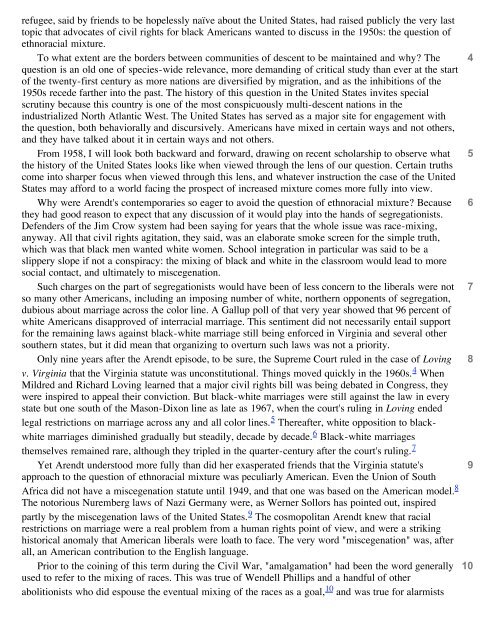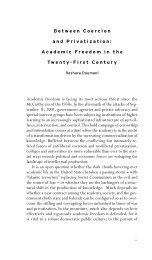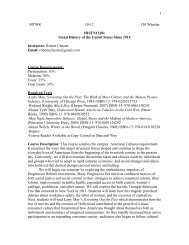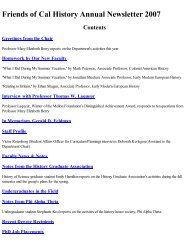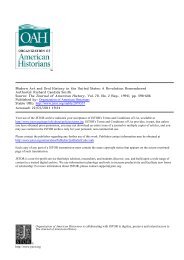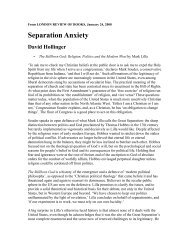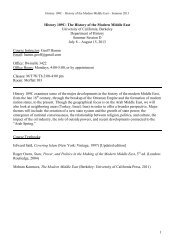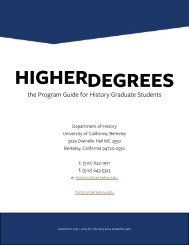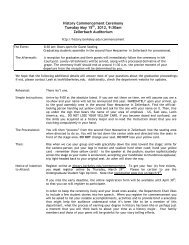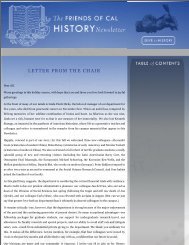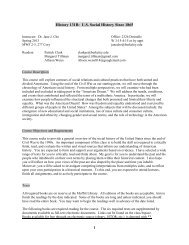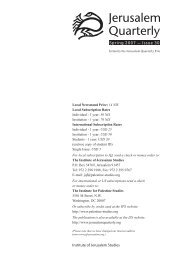David A. Hollinger | Amalgamation and Hypodescent: The Question ...
David A. Hollinger | Amalgamation and Hypodescent: The Question ...
David A. Hollinger | Amalgamation and Hypodescent: The Question ...
You also want an ePaper? Increase the reach of your titles
YUMPU automatically turns print PDFs into web optimized ePapers that Google loves.
efugee, said by friends to be hopelessly naïve about the United States, had raised publicly the very lasttopic that advocates of civil rights for black Americans wanted to discuss in the 1950s: the question ofethnoracial mixture.To what extent are the borders between communities of descent to be maintained <strong>and</strong> why? <strong>The</strong> 4question is an old one of species-wide relevance, more dem<strong>and</strong>ing of critical study than ever at the startof the twenty-first century as more nations are diversified by migration, <strong>and</strong> as the inhibitions of the1950s recede farther into the past. <strong>The</strong> history of this question in the United States invites specialscrutiny because this country is one of the most conspicuously multi-descent nations in theindustrialized North Atlantic West. <strong>The</strong> United States has served as a major site for engagement withthe question, both behaviorally <strong>and</strong> discursively. Americans have mixed in certain ways <strong>and</strong> not others,<strong>and</strong> they have talked about it in certain ways <strong>and</strong> not others.From 1958, I will look both backward <strong>and</strong> forward, drawing on recent scholarship to observe what 5the history of the United States looks like when viewed through the lens of our question. Certain truthscome into sharper focus when viewed through this lens, <strong>and</strong> whatever instruction the case of the UnitedStates may afford to a world facing the prospect of increased mixture comes more fully into view.Why were Arendt's contemporaries so eager to avoid the question of ethnoracial mixture? Because 6they had good reason to expect that any discussion of it would play into the h<strong>and</strong>s of segregationists.Defenders of the Jim Crow system had been saying for years that the whole issue was race-mixing,anyway. All that civil rights agitation, they said, was an elaborate smoke screen for the simple truth,which was that black men wanted white women. School integration in particular was said to be aslippery slope if not a conspiracy: the mixing of black <strong>and</strong> white in the classroom would lead to moresocial contact, <strong>and</strong> ultimately to miscegenation.Such charges on the part of segregationists would have been of less concern to the liberals were not 7so many other Americans, including an imposing number of white, northern opponents of segregation,dubious about marriage across the color line. A Gallup poll of that very year showed that 96 percent ofwhite Americans disapproved of interracial marriage. This sentiment did not necessarily entail supportfor the remaining laws against black-white marriage still being enforced in Virginia <strong>and</strong> several othersouthern states, but it did mean that organizing to overturn such laws was not a priority.Only nine years after the Arendt episode, to be sure, the Supreme Court ruled in the case of Loving 8v. Virginia that the Virginia statute was unconstitutional. Things moved quickly in the 1960s. 4 WhenMildred <strong>and</strong> Richard Loving learned that a major civil rights bill was being debated in Congress, theywere inspired to appeal their conviction. But black-white marriages were still against the law in everystate but one south of the Mason-Dixon line as late as 1967, when the court's ruling in Loving endedlegal restrictions on marriage across any <strong>and</strong> all color lines. 5 <strong>The</strong>reafter, white opposition to blackwhitemarriages diminished gradually but steadily, decade by decade. 6 Black-white marriagesthemselves remained rare, although they tripled in the quarter-century after the court's ruling. 7Yet Arendt understood more fully than did her exasperated friends that the Virginia statute's 9approach to the question of ethnoracial mixture was peculiarly American. Even the Union of SouthAfrica did not have a miscegenation statute until 1949, <strong>and</strong> that one was based on the American model. 8<strong>The</strong> notorious Nuremberg laws of Nazi Germany were, as Werner Sollors has pointed out, inspiredpartly by the miscegenation laws of the United States. 9 <strong>The</strong> cosmopolitan Arendt knew that racialrestrictions on marriage were a real problem from a human rights point of view, <strong>and</strong> were a strikinghistorical anomaly that American liberals were loath to face. <strong>The</strong> very word "miscegenation" was, afterall, an American contribution to the English language.Prior to the coining of this term during the Civil War, "amalgamation" had been the word generally 10used to refer to the mixing of races. This was true of Wendell Phillips <strong>and</strong> a h<strong>and</strong>ful of otherabolitionists who did espouse the eventual mixing of the races as a goal, 10 <strong>and</strong> was true for alarmists


